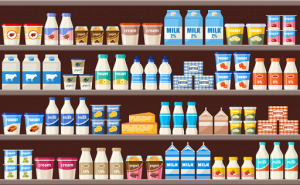
Katia and Brendan Holmes spend their predawn hours and evenings overseeing the milking of 60 cows, and then throwing the milk away.
The couple found out earlier this year that their herd’s milk contains long-lasting toxins known as forever chemicals. They traced the contamination to hay grown on ground near their farm in central Maine where material from wastewater-treatment plants was spread years earlier as fertilizer.
Until recently, few farmers realized that the material could seed toxic chemicals into the ground. Sludge from treatment plants has been spread on farms across the country, partly to add nutrients to the land. The sludge sometimes contains, according to environmental regulators, chemicals known as perfluoroalkyl and polyfluoroalkyl substances, or PFAS, which have been used at industrial sites including paper mills in Maine.
Today, Maine is investigating some 700 sites for potential PFAS contamination from spreading sludge, known as biosolids, beginning in the 1970s. The state has found PFAS in milk, eggs and beef as well as venison and fish. Several contaminated farms have shut down, while others are struggling.
“You can’t see it, you can’t feel it, you can’t taste it,” Ms. Holmes said of the contamination. She runs Misty Brook Farm in the town of Albion with her husband and three sons.
PFAS are a class of thousands of related chemicals that have been used for their water-repellent and fire-retardant qualities in everything from paper coatings to nonstick cookware to firefighting foam. The chemicals have been linked to health problems including kidney and testicular cancers, thyroid disease and high cholesterol.
They are called forever chemicals because they accumulate in people and animals and take a long time to break down. Last month the Environmental Protection Agency sharply lowered the amounts it considers safe for two PFAS chemicals in drinking water to levels that can barely be detected.
PFAS have been found in beef and milk on farms in Michigan, Wisconsin, New Mexico and Colorado, as well as in Maine. Other sources of contamination include landfills and military bases where firefighting foam was used.
The Food and Drug Administration said it has no evidence that specific foods should be avoided because of possible PFAS contamination. Its most recent survey of the food supply found three products—tilapia, cod and shrimp—with detectable PFAS levels out of 92 products sampled. The agency said it is focusing on assisting states by testing foods produced in areas with known PFAS contamination before those products enter the food supply.
“It’s clear that PFAS in the soil, water or air can result in uptake by crops and animals, leading to contaminated foods,” an FDA spokeswoman said. “In those cases, the FDA continues to work with states to help ensure that contaminated foods do not enter the marketplace.”
Maine has done more than many other states to address PFAS contamination on farms. It has set limits for the chemicals in milk and other food products and banned the spreading of biosolids. This spring the state dedicated $60 million to address PFAS contamination on farms, including to compensate farmers for crop losses.
State environmental and agricultural agencies are sampling soil and drinking-water wells near sites where biosolids have been spread, as well as dairy, livestock and crop products. Thirty-three farms have been found to have PFAS contamination above allowable levels, and three have shut down.
“This is devastating for any farmer that is dealing with it,” said Sarah Alexander, executive director of the Maine Organic Farmers and Gardeners Association. “This wasn’t on anybody’s radar until the last couple of years.”
Ms. Alexander’s group and the Maine Farmland Trust raised $1 million this year to create a PFAS emergency fund. Since March the groups have distributed $600,000 to more than 60 farms to replace lost income and help pay for testing. They are helping study whether it is possible to use certain crops to pull PFAS out of the ground.
“We don’t have so much prime farmland that we can afford to lose any of it,” said Amy Fisher, president and chief executive of Maine Farmland Trust.
At a farm in Fairfield, about 10 miles west of Albion, levels of a PFAS chemical known as PFOS used in paper coatings and other products ranged from 12,700 parts per trillion to 32,200 ppt in milk, compared with a level allowed by the state for PFOS in milk of 210 ppt. The EPA in June set a safe-consumption level for PFOS in drinking water of 0.02 ppt. The farm is no longer selling products.
Since 2018, Maine has spent nearly $2.5 million on testing and to install more than 220 water-filtration systems and provide more than 17,000 gallons of replacement water to residents with PFAS contamination. The state expects to provide more than $1 million this year in income replacement to farmers with PFAS contamination.
Katia and Brendan Holmes bought their 600-acre farm in Albion around eight years ago. No one discussed biosolids at the time, they said. Nearly 5,000 cubic yards of sludge from two wastewater-treatment plants was spread on their land from 1992 through 1998, state records show.
In January, the couple tested their milk, pork, beef, eggs and drinking water. They learned that PFOS levels in their milk were over the state limit of 210 ppt. They pulled their milk from 30 stores. They discarded pork and other products that contained the chemicals.
Ms. Holmes said she and her husband each work 120 hours a week, and they employ 10 people. For now, she said, they are doing twice the work to keep the farm running.
They recently bought more than 50 cows with aid from the Maine Organic Farmers and Gardeners Association and the Maine Farmland Trust after testing the animals to ensure they weren’t contaminated, and have been feeding them PFAS-free hay and water. The couple sells the PFAS-free milk, and discards milk from the contaminated cows. Ms. Holmes said they hope the PFAS levels decline enough in their original herd so that the milk can be sold again.
“We’re doing the best we can to figure it out and move forward,” said Ms. Holmes.
Write to Kris Maher at kris.maher@wsj.com























